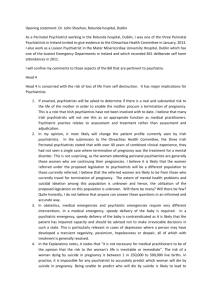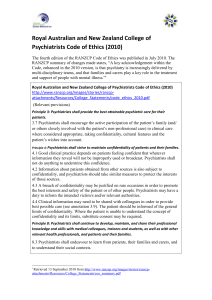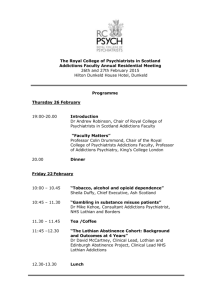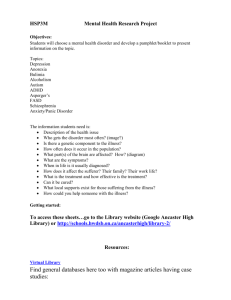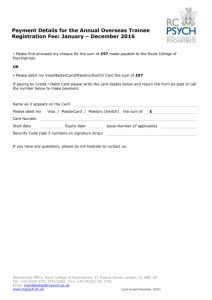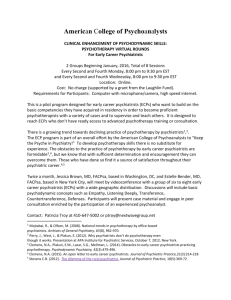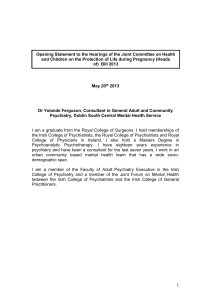the mental health service landscape in Ontario
advertisement
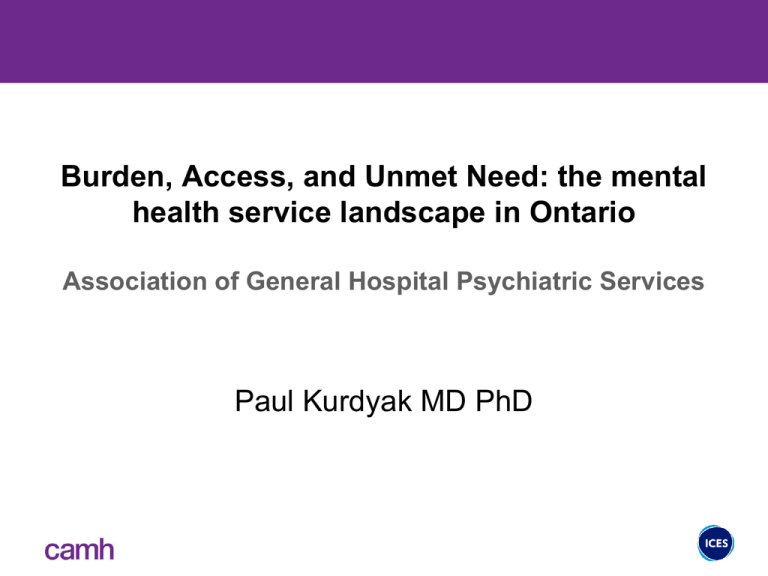
Burden, Access, and Unmet Need: the mental health service landscape in Ontario Association of General Hospital Psychiatric Services Paul Kurdyak MD PhD Disclosures Salary Support from: • ICES • CIHR Overview 1. 2. 3. 4. The burden of mental illness and addictions Medical Comorbidity Access to psychiatrists Increasing help-seeking behaviour – a CAMH natural experiment Opening Eyes, Opening Minds: The Ontario Burden of Mental Illness and Addictions Report 3 Burden of Mental Illness and Addictions in Ontario A collaboration between PHO and ICES Involved CAMH scientists Important because: • Sets a baseline for evaluating future public health or population-based interventions • Has fostered relationships between mental health and public health Unit of Measurement: HALY HALY: Health-Adjusted Life Years HALY = YLL + YERF YLL: Years of life lost due to premature mortality YERF: Equivalent years of healthy life lost due to disease/disability Disease Categories Mental Health Conditions • • • • • • Agoraphobia Bipolar disorder Major depression Panic disorder Schizophrenia Social phobia Addictions • Alcohol use disorders • Cocaine use disorders • Prescription opioid misuse HALYs by Mental Health Condition/ Addiction 250,000 200,000 Female HALYs Male 150,000 Total 100,000 50,000 0 Depression BPD Alcohol Social Phobia SCZ PD Agoraphobia Cocaine Prescription opioid misuse YLLs by Mental Health Condition/ Addiction YLL by Mental Health Condition/ Addiction 20,000 Female 15,000 Male YLL Total 10,000 5,000 0 Alcohol SCZ Depression Cocaine BPD Prescription opioid misuse Social Phobia Agoraphobia PD YERFs by Mental Health Condition/ Addiction YERF by Mental Health Condition/ Addiction 250,000 200,000 Female Male Total YERF 150,000 100,000 50,000 0 Depression BPD Alcohol Social Phobia SCZ PD Agoraphobia Cocaine Prescription opioid misuse HALYs by Age Group 200,000 Health-adjusted life years (HALYs) Schizophrenia 180,000 Bipolar disorder 160,000 Agoraphobia 140,000 Panic disorder 120,000 Social phobia 100,000 Depression Alcohol use disorders 80,000 Prescription opioid misuse 60,000 Cocaine use disorders 40,000 20,000 0 18-24 25-34 35-44 45-54 55-64 65+ Age Groups 10 Comparison to Other BoD Studies All MI&A examined Major depression Bipolar disorder Alcohol use disorders Social phobia Schizophrenia Panic disorder Agoraphobia Cocaine use disorders Prescription opioid misuse All cancers Lung cancer Colorectal cancer Breast cancer Prostate cancer All infectious diseases Hepatitis C S. pneumoniae Human papillomavirus E. coli Hepatitis B MI&A Cancers YLL Infectious Diseases - 100,000 200,000 300,000 400,000 500,000 600,000 700,000 Overview 1. 2. 3. 4. The burden of mental illness and addictions Medical Comorbidity Access to psychiatrists Increasing help-seeking behaviour – a CAMH natural experiment Mortality Burden Dramatically Under-estimated Cause of death is disease-specific. No one dies from schizophrenia Premature mortality in schizophrenia mostly due to cardiovascular disease and risk factors Access to medical care is very poor All Cause Mortality: SCZ and BPD (20062010) Male Female Crude Rate Ratio Age Adjusted RR (95% CI) Crude Rate Ratio Age Adjusted RR (95% CI) SCZ 1.84 2.51 (2.43, 2.60) 2.64 2.34 (2.26, 2.42) BPD 1.80 2.00 (1.95, 2.05) 1.64 1.89 (1.85, 1.94) Schizophrenia Outcomes Following AMI 89,825 AMI Subjects 1087 Allocated to Schizophrenia 88,738 Allocated to No Schizophrenia Excluded: 8 – Missing Data 81 – Not Incident AMI 156 – Death before Discharge 842 with Schizophrenia Mortality Outcome Excluded: 33 – Death within 30 days of discharge 809 with Schizophrenia Process of Care Outcome Excluded: 394 – Missing Data 7628 – Not Incident AMI 9890 – Death before Discharge 70,826 without Schizophrenia Excluded: 1724 - Death within 30 days of discharge 69,102 without Schizophrenia 15 Mortality 2.5 2 1.5 1 0.5 0 Unadjusted Adjusted AOR 1.56, 95% CI 1.08-2.23; p=0.02 16 Cardiac Procedures 1 0.75 0.5 0.25 0 Unadjusted Adjusted AOR 0.48, 95% CI 0.40-0.56; p<0.001 17 Cardiologist Visits 1 0.75 0.5 0.25 0 Unadjusted Adjusted AOR 0.53, 95% CI 0.43-0.65; p<0.001 18 Overview 1. 2. 3. 4. The burden of mental illness and addictions Medical Comorbidity Access to psychiatrists Increasing help-seeking behaviour – a CAMH natural experiment Ability to Access Psychiatrists Primary care physician surveys from multiple jurisdictions - psychiatrists most difficult specialists to access NPS survey 2007 - from 2004 to 2007, ability to accept urgent referral (< 1 week) increased from 44% to 49% Other specialties increased from 60% (2004) to 80% (2007) 2010 survey – 35% primary care physicans rated access to psychiatrists as poor (vs. 4% of GIM and 2% for pediatricians) 20 297 Psychiatrists 230 Contacted 160 Unavailable (70%) 21 297 Psychiatrists 230 Contacted 160 Unavailable (70%) 64 (27%) Need to review referral information and no wait-time estimate 22 297 Psychiatrists 230 Contacted 160 Unavailable (70%) 64 (27%) Need to review referral information and no wait-time estimate 6 (3%) offered immediate appointments (wait times 4-55 days) 23 Ontario Psychiatrist Supply Toronto and Ottawa have 2-4 times more psychiatrists per capita than other regions in Ontario. 24 What Are Psychiatrists Doing? There are large differences between psychiatrist supply across different regions Toronto and Ottawa have large supplies per capita The rest of the province hovers around 10 psychiatrists/100,000 If there are so many psychiatrists (and so many more in Toronto and Ottawa), why are they the most difficult to access? 25 Mean # Unique Patients and # New Patients per Year Low supply area psychiatrists see twice as many patients and twice as many new patients/year 26 Psychiatrists vs Patients in Toronto 25% of psychiatrists see 6% of outpatients 27 Patient Income Across Visit Categories Toronto Almost half of patients seen >16 times/year are in the top income quintile 28 Summary Psychiatrists in high supply areas see fewer patients, fewer new patients and see these fewer patients more frequently and for longer per visit In high supply areas, as visit frequency increases, patient SES increases The increased psychiatrist supply does not translate into better follow-up post-hospitalization Access to psychiatrists does not improve with increased per capita supply 29 Follow-up 30 days Post-Hospitalization 50 Schizophrenia Bipolar Depression 45 40 35 30 25 20 15 10 5 0 No Visit PC Visit Only Psych Visit Only Shared Care 30 Readmission 31-60 days Post-Hospitalization 10 Schizophrenia 9 Bipolar 8 Depression 7 6 5 4 3 2 1 0 No Visit PC Visit Only Psych Visit Only Shared Care 31 Summary 1. 2. 3. 4. The burden of mental illness and addictions Medical Comorbidity Access to psychiatrists Increasing help-seeking behaviour – a CAMH natural experiment 32 Mental Illness and Addiction Treatment Rates Two thirds of people with depression do not seek help Up to 90% of people with addictions do not seek treatment Very little evidence on increasing treatment-seeking behaviours to address burden of mental illness and addiction The CAMH Campaign A Natural Experiment The campaign is the only intervention that occurred in March 2010 (nothing else changed that could explain changes in visit volumes) Permits an evaluation of the campaign using quasiexperimental methods ED volumes AND Gen Psych. Assessment Clinic volumes – direct-to-consumer marketing vs. service provider marketing Methods All patients who presented to the ED (N=29,069) and the Gen Psych. Assessment Clinic (N=8326) from April 1, 2006 to December 31, 2011. Grouped monthly Pre-campaign – April 1, 2006 to March 31, 2010 Post-campaign – April 1, 2010 to December 31, 2011 Also used regional-level data for system-level analyses (preliminary) Statistical Analysis Time series analysis methods used to model the data series and test for an effect of the campaign. Geographic Information Systems (GIS) using patient postal code for mapping patient distance from ED. ED Volumes 700 600 500 400 300 200 100 0 Apr/06 Oct/06 Apr/07 Oct/07 Apr/08 Oct/08 Apr/09 Oct/09 Apr/10 Oct/10 Apr/11 Oct/11 Time Actual # visits General Psychiatry Assessment Clinic Volumes 300 250 200 150 100 50 0 Apr/06 Oct/06 Apr/07 Oct/07 Apr/08 Oct/08 Apr/09 Oct/09 Apr/10 Time Number of referrals Oct/10 Apr/11 Oct/11 ED Volumes: % new to CAMH and Region 600 CAMH Foundation 550 Monthly ED Visits, Proportion New (%) 500 450 400 350 CAMH Monthly Visits New to CAMH (Actual) New to CAMH (%) New to TCLHIN (%) New to TCLHIN (Actual) 300 250 200 150 100 50 0 Time Pre-Campaign Map Post-Campaign Map Maps Side by Side Limitations Just starting system context • Don’t know if we are duplicating services • Preliminarily – campaign increased volume in all categories: previous CAMH ED visit, new to CAMH, and new to region Main Findings Addressing stigma increases help-seeking and referral behaviour Can have a significant impact on volumes Low treatment rates can be addressed using marketing strategies addressing stigma AND highlighting service availability Summary Huge burden of mental illness and addictions in Ontario High supply of psychiatrists in Toronto and incentivization are perpetuating poor access in the face of very high psychiatrist supply Access to care at high times of need (posthospitalization) is poor CAMH campaign suggests there is a large unmet need “market” that is currently not being served
